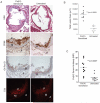Interleukin-17-dependent autoimmunity to collagen type V in atherosclerosis
- PMID: 20814021
- PMCID: PMC3010213
- DOI: 10.1161/CIRCRESAHA.110.221069
Interleukin-17-dependent autoimmunity to collagen type V in atherosclerosis
Abstract
Rationale: Considerable evidence shows atherosclerosis to be a chronic inflammatory disease in which immunity to self-antigens contributes to disease progression. We recently identified the collagen type V [col(V)] α1(V) chain as a key autoantigen driving the Th17-dependent cellular immunity underlying another chronic inflammatory disease, obliterative bronchiolitis. Because specific induction of α1(V) chains has previously been reported in human atheromas, we postulated involvement of col(V) autoimmunity in atherosclerosis.
Objective: To determine whether col(V) autoimmunity may be involved in the pathogenesis of atherosclerosis.
Methods and results: Here, we demonstrate Th17-dependent anti-col(V) immunity to be characteristic of atherosclerosis in human coronary artery disease (CAD) patients and in apolipoprotein E-null (ApoE(-/-)) atherosclerotic mice. Responses were α1(V)-specific in CAD with variable Th1 pathway involvement. In early atherosclerosis in ApoE(-/-) mice, anti-col(V) immunity was tempered by an interleukin (IL)-10-dependent mechanism. In support of a causal role for col(V) autoimmunity in the pathogenesis of atherosclerosis, col(V) sensitization of ApoE(-/-) mice on a regular chow diet overcame IL-10-mediated inhibition of col(V) autoimmunity, leading to increased atherosclerotic burden in these mice and local accumulation of IL-17-producing cells, particularly in the col(V)-rich adventitia subjacent to the atheromas.
Conclusions: These findings establish col(V) as an autoantigen in human CAD and show col(V) autoimmunity to be a consistent feature in atherosclerosis in humans and mice. Furthermore, data are consistent with a causative role for col(V) in the pathogenesis of atherosclerosis.
Figures







References
-
- Sherer Y, Shoenfeld Y. Mechanisms of disease: atherosclerosis in autoimmune diseases. Nat Clin Pract Rheumatol. 2006;2:99–106. - PubMed
-
- Hansson GK. Inflammation, atherosclerosis, and coronary artery disease. N Engl J Med. 2005;352:1685–1695. - PubMed
-
- Murray CJ, Lopez AD. Global mortality, disability, and the contribution of risk factors: Global Burden of Disease Study. Lancet. 1997;349:1436–1442. - PubMed
-
- Sigal LH. Basic science for the clinician 44: atherosclerosis: an immunologically mediated (autoimmune?) disease. J Clin Rheumatol. 2007;13:160–168. - PubMed
-
- Blasi C. The autoimmune origin of atherosclerosis. Atherosclerosis. 2008 - PubMed
Publication types
MeSH terms
Substances
Grants and funding
LinkOut - more resources
Full Text Sources
Medical
Molecular Biology Databases
Miscellaneous

